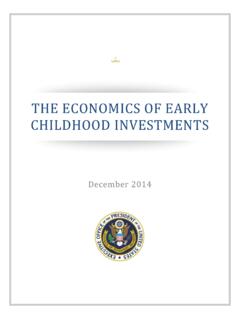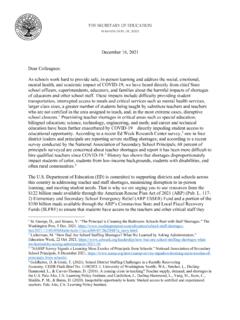Transcription of Higher Education in India: Challenges and Opportunities
1 Journal of Education and Practice ISSN 2222-1735 (Paper) ISSN 2222-288X (Online) , , 2017 39 Higher Education in India: Challenges and Opportunities Younis Ahmad Sheikh PhD Research Scholar, MPISSR, Ujjain Abstract The world has realized that the economic success of the states is directly determined by their Education systems. Education is a Nation s Strength. A developed nation is inevitably an educated nation. Indian Higher Education system is the third largest in the world, next to the United States and China. Since independence, India as a developing nation is contentiously progressing in the Education field. Although there have been lot of Challenges to Higher Education system of India but equally have lot of Opportunities to overcome these Challenges and to make Higher Education system much better.
2 It needs greater transparency and accountability, the role of colleges and universities in the new millennium, and emerging scientific research on how people learn is of utmost important. India need well skilled and highly educated people who can drive our economy forward. India provides highly skilled people to other countries therefore; it is very easy for India to transfer our country from a developing nation to a developed nation. The current study aims to highlight the Challenges and to point out the Opportunities in Higher Education system in India. Keywords: Education , Opportunities , Challenges , Colleges, Universities Introduction India's Higher Education system is the world's third largest in terms of students, next to China and the United States. In future, India will be one of the largest Education hubs.
3 India's Higher Education sector has witnessed a tremendous increase in the number of Universities/University level Institutions & Colleges since independence. The Right to Education Act which stipulates compulsory and free Education to all children within the age groups of 6-14 years, has brought about a revolution in the Education system of the country with statistics revealing a staggering enrolment in schools over the last four years. The involvement of private sector in Higher Education has seen drastic changes in the field. Today over 60% of Higher Education institutions in India are promoted by the private sector. This has accelerated establishment of institutes which have originated over the last decade making India home to the largest number of Higher Education institutions in the world, with student enrolments at the second highest (Shaguri, 2013).
4 The number of Universities has increased 34 times from 20 in 1950 to 677 in 2014. Despite these numbers, international Education rating agencies have not placed many of these institutions within the best of the world ranking. Also, India has failed to produce world class universities. Today, Knowledge is power. The more knowledge one has, the more empowered one is. However, India continues to face stern Challenges . Despite growing investment in Education , 25 per cent of its population is still illiterate; only 15 per cent of Indian students reach high school, and just 7 per cent graduate (Masani, 2008). The quality of Education in India whether at primary or Higher Education is significantly poor as compared to major developing nations of the world. As of 2008, India's post-secondary institutions offer only enough seats for 7 per cent of India's college-age population, 25 per cent of teaching positions nationwide are vacant, and 57 per cent of college professors lack either a master's or PhD degree (Newsweek, 2011).
5 As of 2011, there are 1522 degree-granting engineering colleges in India with an annual student intake of 582,000 (Science and Technology Education , 2009) plus 1,244 polytechnics with an annual intake of 265,000. However, these institutions face shortage of faculty and concerns have been raised over the quality of Education (Mitra, 2008). Despite these Challenges Higher Education system of India equally have lot of Opportunities to overcome these Challenges and have the capability to make its identity at international level. However, it needs greater transparency and accountability, the role of universities and colleges in the new millennium, and emerging scientific research on how people learn is of utmost important. India provides highly skilled people to other countries therefore; it is very easy for India to transfer our country from a developing nation to a developed nation.
6 Growth of Higher Education Sector in India As Higher Education systems grow and diversify, society is increasingly concerned about the quality of programmes, public assessments and international rankings of Higher Education institutions. However these comparisons tend to overemphasise research, using research performance as a yardstick of institutional value. If these processes fail to address the quality of teaching, it is in part because measuring teaching quality is challenging (Hernard, 2008) India has been always been a land of scholars and learners. In ancient times also, India was regarded all over the world for its universities like Taxila, Nalanda, Vikramshila and its scholars. By independence India had 20 universities, 500 colleges enrolling about 2,30,000 students. Since independence India has progressed Journal of Education and Practice ISSN 2222-1735 (Paper) ISSN 2222-288X (Online) , , 2017 40 significantly in terms of Higher Education statistics.
7 This number has increased to 659 Universities and 33023 colleges up to December 2011-12. Central Government and state Governments are trying to nurture talent through focusing on the number of Universities and Colleges for expansion of Higher educations. There is no doubt to the fact that much of the progress achieved by India in Education has come from private sector. In fact the public sector and private sector is not in opposition to each other but they are working simultaneously in Indian Education sphere. UGC is the main governing body that enforces the standards, advises the government and helps coordinate between center and states. The chart & shown below depicts the growth of universities and colleges in India from 1970 to 2012 respectively. The number of universities has grown more than six times in last four decades and the number of colleges has been increased from 3603 in 1970-71 to 33000 colleges in 2011-12.
8 The growth of universities and Colleges in India from 1970 to 2012 Chart Chart Source: Higher Education in India: Twelfth Five Year Plan (2012-17) and beyond FICCI Higher Education Summit 2012 Challenges in Higher Education in India It is our 69th year of independence still our Education system has not been developed fully. We are not able to list a single university in top 100 universities of the world. Various governments changed during these six decades. They tried to boost the Education system and implemented various Education policies but they were not sufficient to put an example for the universe. UGC is continuously working and focusing on quality Education in Higher Education sector. Still we are facing lot of problems and Challenges in our Education system. Some of the basic Challenges in Higher Education system in India are discussed below: Enrolment: The Gross Enrolment Ratio (GER) of India in Higher Education is only 15% which is quite low as compared to the developed as well as, other developing countries.
9 With the increase of enrolments at school level, the supply of Higher Education institutes is insufficient to meet the growing demand in the country. Equity: There is no equity in GER among different sects of the society. According to previous studies the GER in Higher Education in India among male and female varies to a greater extent. There are regional variations too some states have high GER while as some is quite behind the national GER which reflect a significant imbalances within the Higher Education system. quality : quality in Higher Education is a multi-dimensional, multilevel, and a dynamic concept. Ensuring quality in Higher Education is amongst the foremost Challenges being faced in India today. However, Government is continuously focusing on the quality Education .
10 Still Large number of colleges and universities in India are unable to meet the minimum requirements laid down by the UGC and our universities are not in a position to mark its place among the top universities of the world. Infrastructure: Poor infrastructure is another challenge to the Higher Education system of India Journal of Education and Practice ISSN 2222-1735 (Paper) ISSN 2222-288X (Online) , , 2017 41 particularly the institutes run by the public sector suffer from poor physical facilities and infrastructure. There are large number of colleges which are functioning on second or third floor of the building on ground or first floor there exists readymade hosieries or photocopy shops.















